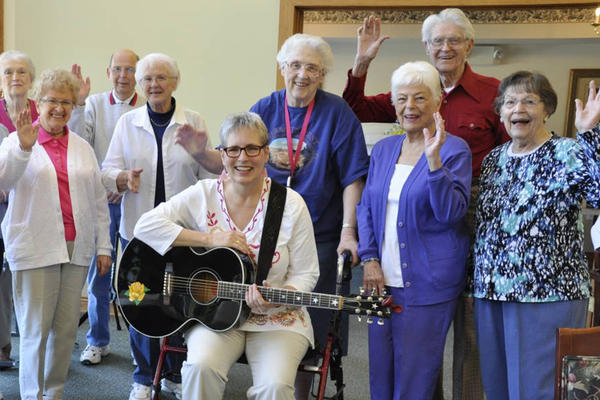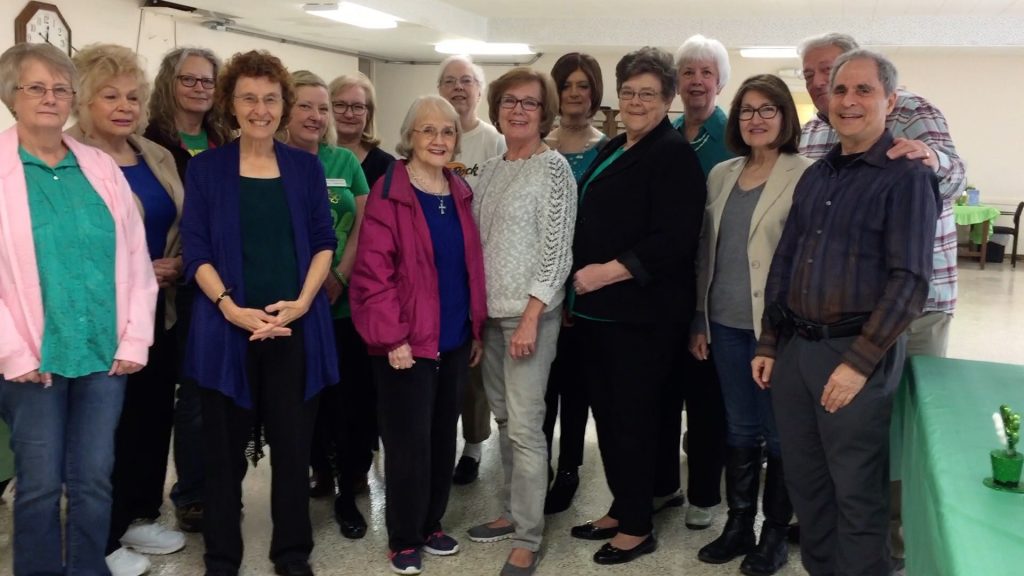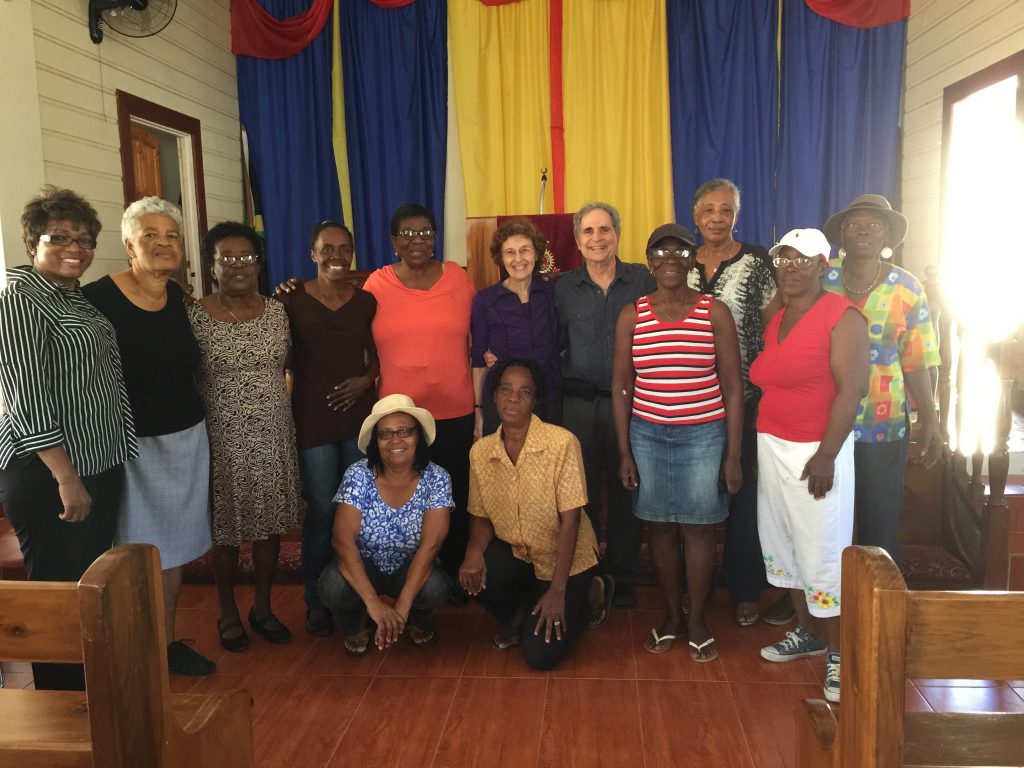Posts Tagged ‘alzheimer’s’
Adapting Hobbies to Meet Changing Abilities
Years ago, I worked as an activity director at a county home in Butler, Mo. There I learned about adapting hobbies to meet changing abilities. Albert taught me that even when you can’t grip a domino, you can still enjoy the game. Every Wednesday, we dropped him off at the town square for his weekly session. A friend helped him place the pieces and he often won. Sadie taught me the power of memorizing poetry. Though she could no longer see the world around her, she enriched her inner world by memorizing dozens of verses. Visiting her was like opening a book of best-loved poems. The residents all taught me the joy of sitting around a table together, working on a project. Even if the project didn’t work out the way we envisioned, the energy and camaraderie did.
Earlier this year, we had the opportunity to offer a presentation on engaging through creative activities for the National Association of Activity Professionals. These professionals are so vital in helping people stay creative and connected throughout the dementia journey. We were inspired by their depth of knowledge, compassion, and eagerness to learn.
As part of our presentation, we discussed adapting hobbies to meet changing abilities. We shared ideas from Connecting in the Land of Dementia, and our participants offered ideas from their experiences. Here are some tips for adapting hobbies:
Ask yourself: What does the person love most about doing this activity? What are the most important components for them?
For example, for gardeners, is it the feel of their hands in the soil? Is it producing flowers or harvesting vegetables? Is it having something to take care of? Or is it the ritual coffee and cookies enjoyed after the work is done?
For those who like quilting, is it the finished product or making the squares? Is it the companionship with other quilters? Or the texture and colors of the fabric?
For scrapbookers, do they enjoy looking through photos or gluing pictures on the page? Do they like leafing through magazines and cutting out pertinent words and pictures or adding stickers and other playful accents. Or maybe it’s the companionship of working together.
By gathering answers to these types of questions, you can break down the activity’s components and encourage people living with dementia to keep pursuing their interests.
If you have ideas for adapting activities, we’d love to hear about them. For more information on the NAAP, visit https://naap.info/
Deborah Shouse is the author of Connecting in the Land of Dementia: Creative Activities to Explore Together and Love in the Land of Dementia: Finding Hope in the Caregiver’s Journey.
Widening the World Through Travel
As the waiter served dessert, Lori La Bey looked around the table at her family and smiled. She couldn’t believe she had pulled this off — her children, her siblings and their children, and her parents all enjoying a Caribbean cruise together. Her mother was living with Alzheimer’s and her father had brain cancer: they had assumed they wouldn’t get to travel again. They were beaming and Lori knew all her planning had been worth it. She was widening the world through travel.
She still treasures the family pictures from this trip. This meaningful travel experience inspired Lori, founder and host of Alzheimer’s Speaks, to orchestrate a cruise for people who are living with dementia and their families.
“Travel is a normal part of life,” Lori says. “When you stop traveling, your world becomes smaller.”
From her years caring for her mom, Lori understands how easy it is to feel isolated and stuck. She also understands the joy of engaging in the world, trying new things, and meeting new people. Her trip enriched her family and she wants to offer others that gift of connection and adventure.
Lori also learned some tips from traveling with her parents. Here are a few ideas for creating a smooth traveling experience for yourself and for someone who is living with dementia:
Create a flexible travel experience. Lori chose cruising because it can be reasonably priced, you can unpack once and stay in the same room the entire trip, and there’s lots of flexibility with eating (including free room service), activities, and touring. Cruising is also ideal for the intergenerational experience, offering activities for all ages.
Make the person living with dementia part of planning the trip. Discuss the trip with all involved, asking for feedback and talking about what each person really wants to do. Incorporate those dreams into the trip.
Empower your travelers. Lori packed all her parents things into one giant suitcase. Her father had always been the one managing the luggage and he really wanted something to carry. “I hadn’t thought to pack a couple of small bags so he and my mom could feel like regular travelers,” Lori says. “People want something to be in charge of so they don’t feel left out.”
Work with a travel agent and make your life easier. Plan in advance for noise, long transfers, layovers, long car rides, and other chaos. If flying, call the airport if you need to arrange for wheelchairs or other inner airport transportation. To mute noises, bring earplugs. Carry along items that soothe and comfort each of us, including favorite music and head phones. If you’re cruising, talk to the cruise lines in advance, discussing special needs, including dietary, medical, and any mobility issues.
Take pictures and videos and document these precious moments. You’ll enjoy looking through these memories again and again together.
“Travel is about being together and widening your world,” Lori says. “It’s a wonderful way to build those moments of magical and meaningful connection.”
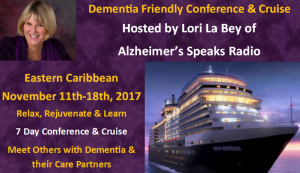 For an amazing way to widen your world, consider Lori’s upcoming November Dementia Friendly Conference and Cruise. Lori and a team of educators, including a panel of inspiring people who are living with dementia, have planned a nurturing, connecting, educational, and inspiring Caribbean trip. For more information, visit, https://alzheimersspeaks.com/cruise-with-us
For an amazing way to widen your world, consider Lori’s upcoming November Dementia Friendly Conference and Cruise. Lori and a team of educators, including a panel of inspiring people who are living with dementia, have planned a nurturing, connecting, educational, and inspiring Caribbean trip. For more information, visit, https://alzheimersspeaks.com/cruise-with-us
Deborah Shouse is the author of Connecting in the Land of Dementia: Creative Activities to Explore Together and Love in the Land of Dementia: Finding Hope in the Caregiver’s Journey.
Engaging during the Dementia Journey: One Story and Six Tips
My satchel was packed with potential connectors, not the electrical type, but the emotional, engaging type. I had a sheaf of favorite poems, an Audubon bird book, a list of songs Mom and I liked, some bright red Mardi Gras beads, several colorful scarves, and some paper and markers. I was eager to see what Mom might fancy and I felt prepared for any creative impulse. But as usual, my mom surprised me. When I walked into her room in the memory care community, she was sitting on the bed, fiddling around with a blanket. She smiled and held out her hands. I sat beside her, held her hands, and smiled at her. She laughed. I laughed. She made a little funny face. I mirrored her. I followed her lead until she suddenly gripped my fingers and closed her eyes. I closed mine, but kept sneaking peeks at her. She was asleep, a lazy smile on her face, so I closed my eyes and rested with her. This was one of many ways of engaging during the dementia journey.
Spontaneity and surrender were two of the many lessons my mom taught me during her dementia journey. I loved preparing for our time together, cobbling together ideas to engage us both. Sometimes we sat quietly, leafing through magazines. Other times, I sang Mom show tunes. Still other times, I simply went with the flow and enjoyed Mom’s energy and spontaneity.
My mom has since passed away but her spiritual and emotional gifts linger on. When I visit friends who are living with dementia, here are a few ideas for connecting.
- Choose a quiet space relatively free of distractions.
- Select a time of day when you both have lively energy.
- Bring a project (or projects) you’d both enjoy.
- If the person is shy about creative projects, issue a low-key invitation, such as, “Want to help me with this project?”
- Allow the activity to unfold at its own pace, offering support as necessary and encouragement along the way. Enjoy the process.
- If the activity doesn’t go as planned, don’t worry. Go with the flow and relish your time together.
(A version of this story was originally published in eCareDiary)
Deborah Shouse is the author of Connecting in the Land of Dementia: Creative Activities to Explore Together and Love in the Land of Dementia: Finding Hope in the Caregiver’s Journey.
Art as a Creativity Catalyst: Featuring Grace and Spencer Townley-Lott

How do we keep our sense of connection and creativity through the caregiving journey? That was a question I often asked myself. I wanted to share this story of an extraordinary couple– artist, dementia advocate, and social worker Grace Townley-Lott and her husband, puppeteer, actor, and playwright, Spencer Townley-Lott. Both use art as a creativity catalyst in their work and throughout their lives.
Their elders inspired them. Grace and Spencer were teenagers when her grandmother and his great-grandmotherwere going through a dementia journey. The experience was difficult and impactful.
Grace became a social worker, specializing in older adults and learning how to communicate with people who were living with dementia, often through art.
“It’s incredible how the arts open people up,” Grace says. “Someone who hasn’t painted in 20 years picks up a brush and creates something beautiful. Someone who hasn’t spoken in ages delivers a zinger of a one-liner. Every day, I see how creative people are and the connections that are still possible.”
As Grace unfurled her work experiences, Spencer gained a new understanding of his great-grandmother’s last years. He used those insights to create a critically acclaimed play, Blossom. This play, which utilizes puppets, was funded by a Jim Henson Foundation Grant. It focuses on James Blossom, a retired painter who is living with dementia and his family’s changing relationships.
Caregivers often wonder: “How do we keep creativity alive?” Grace and Spencer were kind enough to share some ideas.
Engaging in New Endeavors: Grace
Try to be in the moment, despite your list of tasks. Respond to and validate emotions. Be willing to go with the flow so you can allow creative sparks.
Pay attention to facial expressions as you invite your loved one to engage. If you start dancing, do their eyes light up and do they laugh? If you offer watercolors and cue your partner to touch the brush to wet paper, does he respond with joy when the color blooms on the page? If you’re having a hard time getting your partner to take a shower, croon a song and waltz with him into the shower. If it doesn’t work, that’s okay, too! But if it does work, it’s a lovely and practical way to connect, create, and take care of physical needs as well.
Sometimes it takes reframing the situation to view the possibilities. An outside person or idea can often expand your thinking.
Creativity Tips for the Care Partner: Spencer
Sometimes, physical actions can help release tension to allow for more creative thinking. Deep breaths and stretching can help you loosen up at first. In the theater world, we start every rehearsal with a physical game or action to help us get focused and leave our stress at the door. Try wiggling and shaking your feet and hands, giving yourself a brief facial massage, stretching as tall as you can, and twisting gently left and right. You’re getting the blood flowing, leaving the worried part of you in the hallway, and getting ready to create.
Allow room for surprises. Try to set the tone by modeling joy and openness. Be willing to try again.
Connecting through Art: Grace
I love viewing art with people who have dementia. Art is so subjective, so there’s no wrong answer to the question, “What do you see?” You can take that first question and lead it along into a fascinating conversation, one question at a time, building a fulfilling conversation with an individual or a group.
In these art viewings, a discussion about a painting can tap into emotions that would otherwise be left undiscussed, or it could lead into a beautiful conversation about the person’s childhood, for example. You never know where the conversation will lead! This creates a failure-free situation where a person with dementia can excel and their answers are valued.
Connecting through Puppets: Spencer
Puppets offer a level of separation for the care partner. For people living with dementia, a puppet’s cues may be simpler to decode, dramatically expressing joy or sorrow. The puppet can place a hand on a shoulder and offer many opportunities for sensory engagement.
Puppets can also encourage intergenerational play, creating connections between family members who may be unsure who to communicate with their loved one with dementia.
Keeping Your Creative Flow: Spencer and Grace
“Creativity is inherent in all of us,” Spencer says. “It’s a muscle you can strengthen. Be patient with yourself. The first day, you can only do one push-up. The second day, you can accomplish two or three. That’s what creativity and artistry feels like. Start small. You are laying the foundation. And it gets easier.”
“Be present and be ready for anything,” Grace says. “By asking your loved ones for advice, truly listening to them, and just being with them, you can form beautiful interactions throughout life.”
To learn more about Spencer, visit
To learn more about Grace, visit
gracetownley.com and theartfuloven.com
Grace is the Director of Truly Inspired Outreach and Education for True Care Home Health.
Deborah Shouse is the author of Connecting in the Land of Dementia: Creative Activities to Explore Together and Love in the Land of Dementia: Finding Hope in the Caregiver’s Journey.
Embracing Person-Centered Dementia Values: The Dementia Action Alliance
One by one, we say hello via video conferencing. We are writers, artists, and arts advocates from all over the country. One sculptor enriches the visual aspects of our meeting by strolling through a museum, giving us occasional glimpses of vibrant art. We meet another artist’s dog. Via video, we see each other’s offices and learn each other’s names and goals. Some of the participants are living with dementia; some are not. All of us are brainstorming ways to use the arts as a catalyst to connect people. Already it is working: through the Dementia Action Alliance, our arts group is already engaging in deep and honest conversation, discussing ways to weave creativity and the arts through June’s conference in Atlanta, and exploring ways we can help others stay connected through the arts.
I have long admired the Dementia Action Alliance and feel honored to be part of their creative process. Their “Person-Centered Dementia Values and Principles” were inspired by the Pioneer Network and have been customized by people living with dementia. Karen Love, Executive Director of DAA, tells us, “Because people who have dementia are the experts, the values are written from their perspective in first person narrative. This orientation helps us focus on what is important.”
Here are some of their core ideas:
Person-Centered Dementia Values and Principles
• I am a person living with dementia. Spend time getting to know me and relating to me as a person with a unique background, life history, interests and capabilities.
• Help me stay connected to what is important to me. Although aspects of my personhood may become increasingly hidden, I am still here.
• A reciprocal relationship is important to me. Autonomy, choices, dignity, privacy, self-determination are fundamental to my well-being.
• Support my holistic emotional, social, physical, cultural, sexual, and spiritual dimensions.
• Promote my personal growth and development. Help me continue to experience purpose, meaning, relationships and enjoyment in my daily life.
• Partner with me, utilize my strengths, and provide the right amount of support and opportunities I need to achieve my goals.
• Some dementia symptoms may interfere with my communication. I communicate the best I can; assume positive intent. Attempt to understand my needs and my reality. Please be compassionate.
For me, reading these principles reminds me how much we are all alike.
For more information on this topic and to learn about the DAA’s upcoming conference:
Conference: Re-Imagine Life with Dementia
You’ll enjoy reading this white paper on Living with Dementia: Changing the Status Quo, DAA
Deborah Shouse is the author of Connecting in the Land of Dementia: Creative Activities to Explore Together and Love in the Land of Dementia: Finding Hope in the Caregiver’s Journey.
Five Tips for Using Music to Connect
Even as a child, I was using music to connect with my parents. My father was a DJ and my mother enjoyed show tunes and old standards. Those songs often played on our record player and we all enjoyed listening. Later, I used that same music to connect me to my mom and dad during her dementia journey.
Today, I am thrilled to sharing the insights of Mary Sue Wilkinson, Founder of Singing Heart to Heart. Just reading her ideas makes me want to burst into song.
Meaningful Visits: 5 Tips for Using Music to Connect
By: Mary Sue Wilkinson, Founder of Singing Heart to Heart
Let’s face it. Visiting someone with Alzheimer’s or dementia can be hard. You want to connect. You want to make them happy. But things have changed. I understand. I’ve been there. I found a way to connect that I’d like to share with you. Let me explain.
My father in law Virgil had dementia and eventually lost all language. The only thing he could say was “gaba gaba.” His face would light up when I came to visit. I think he knew I was someone he loved. But after the first hug and shared smile…I would flounder. Carrying on a one sided conversation only went so far. I would leave feeling lonely and discouraged. I bet he felt the same. As much as I hate to admit it, I began to put off visiting him.
Virgil had been a Church of the Brethren minister. He knew and loved all the old southern gospel songs. One day I took my guitar and began to play and sing for him. I figured I could at least entertain him for an hour or so. I started singing an old favorite: I’ll Fly Away. Virgil lifted his head, broke into a huge smile and began to sing along. Every word. Perfect pitch. He even added harmony From then on music was the focus of our visits.
It didn’t cure Virgil’s dementia. He couldn’t carry on a conversation with me when the song ended. (Although I have seen this happen with others.) But we connected in a meaningful, joyful activity. This was something we could do together. I began to look forward to our visits. I had learned that we could be together without conversation.
Have you ever hesitated to visit someone with dementia or Alzheimer’s because you were afraid you wouldn’t know what to do or what to talk about? Do you feel like you are losing your connection to your loved one or friend?
Music was the “gift” that allowed me to have meaningful, connected, and happy visits with my father-in-law. I hope that it can do the same for you. Here are some suggestions to get you started.
5 tips for using music when you visit someone with dementia
1. When dementia has progressed to the point where conversations are difficult, or even impossible – turn to music. Singing together and/or listening to music can bring happiness regardless of skill or memory. Remember that you are seeking moments of joy and connection. A shared music experience may or may not elicit shared memories. What it will do, is give you a shared experience, in the moment.
2. Bring music with you to your visit – either holiday music or music popular when they were young. Plan ahead and then share it by saying, “I brought some music I thought we could enjoy together.” If the person you are visiting does not have a CD player in their room, bring one from home, borrow one from the activity director or consider purchasing one as a gift. (You can purchase or download my CD of well known songs here.)
3. If you don’t play recorded music, you can simply sing. Even singing one or two songs will lift spirits – for everyone. It’s a great way to establish a positive mood and communicate that you are someone “good.” Choose well known and simple songs such as You Are My Sunshine, My Bonny Lies Over the Ocean, or I’ve Been Working on the Railroad. Or choose well known holiday songs or songs of faith. These songs often evoke the strongest response from people, bringing a powerful connection. (You can download my free song guides here on my website.)
4. Involve your children or grandchildren in planning a musical visit. Give them the job of figuring out what was popular when your loved one was in their 20’s and 30’s and downloading that music to play during the visit. Let them use their smart phone to make a playlist. Do they have a wireless speaker they could bring along?
If your loved one asks for a song you don’t have ready, simply go to You Tube to find it.
5. Add some energy and fun to your musical time together by patting and clapping to the beat. Don’t hesitate to dance. You may be surprised. Sometimes people can dance better than they can walk. Standing or sitting you can still “dance” together and enjoy a sweet connection.
Remember: “When words fail, music speaks.” (Hans Christian Anderson)
 Mary Sue Wilkinson is the founder of Singing Heart to Heart where each year she leads close to 400 singing and music experiences for seniors. She specializes in using music in dementia care. Mary Sue is the author of “Songs You Know By Heart: A Simple Guide for Using Music in Dementia Care” which includes her recording of favorite sing alongs as well as a contribution from Teepa Snow. Learn more and contact Mary Sue at Singing Heart to Heart.com
Mary Sue Wilkinson is the founder of Singing Heart to Heart where each year she leads close to 400 singing and music experiences for seniors. She specializes in using music in dementia care. Mary Sue is the author of “Songs You Know By Heart: A Simple Guide for Using Music in Dementia Care” which includes her recording of favorite sing alongs as well as a contribution from Teepa Snow. Learn more and contact Mary Sue at Singing Heart to Heart.com
Deborah Shouse is the author of Connecting in the Land of Dementia: Creative Activities to Explore Together and Love in the Land of Dementia: Finding Hope in the Caregiver’s Journey.
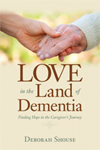

Sharing Ideas for Staying Connected
“How do we stay connected during the dementia journey?” This is a question with dozens of creative answers. Recently, we spent time at Northland Shepherd Center, hosted by Dianna Englander. We were sharing ideas for staying connected with the Together We Care Caregiver Support Group, a lovely gathering of family caregivers and friends. 
Caregiving is such a creative practice, demanding flexibility, humor, and the willingness to make mistakes and try again. We discussed ideas from Connecting in the Land of Dementia, including incorporating singing, laughter, and art into everyday life. We also explored the power of nature and talked about unique concepts for bringing the outdoors inside. We brainstormed different ways we could prepare food together and connect in the kitchen.
Here are some extra ideas we learned from our audience. I’ve changed the names to protect people’s privacy.
Anne’s father, who was normally very active, became very upset when his care facility had to temporarily curtail his movements, due to a flu outbreak.
“I want to go to the hospital,” he told the care staff repeatedly. Finally, they called Anne and asked her to come over.
“Dad was just wild,” she told us. “So I asked him to take a deep breath with me, and told him we were going to watch a basketball game before we problem-solved.” They watched an hour of basketball, which soothed both of them.
“I want to go to the hospital,” her father said.
“Why?” she asked.
“So I won’t feel alone,” he said. “I’m scared to be alone.”
Anne realized how social her father was, always walking down the hallways, greeting people, spending time visiting. She instantly began to problem solve, getting permission to walk down the corridors, wearing protective masks, gathering phone numbers of her father’s friends at the home, so he could call them.
“Taking a break and doing something soothing first really helped us figure out the problem and then solve it,” she said.
…………………….
Before her dementia advanced, Sandra’s friend loved singing in the church choir. Now, when Sandra visits her, her friend frequently asked the same question over and over. Sandra turns to beloved hymns they both know so well and when her friend becomes anxious, starts singing to change the energy. Soon, they are both singing, as they have for so many years, the old hymns guiding them back to a deep connection.
…………………….
Patriotic songs inspired Alvin’s father, Fred. So often, Fred literally tuned out the singers who came to entertain at his memory care community. One day, the group began singing “The Star Spangled Banner,” Instantly, Fred stood and put his hand over his heart. He sang along and kept standing and singing through all the familiar patriotic melodies. Afterwards, he talked about his time in the service, breaking his usual stoic silence.
At the end, we all felt a sense of renewal and companionship. Sharing these important creative ideas had enriched our lives and inspired us anew.
I’d love to hear your ideas for staying connected. Please email me at myinfo@pobox.com.
For more information about the Northland Shepherd Center, visit http://northlandsc.org/about-nsc.html
Deborah Shouse is the author of Connecting in the Land of Dementia: Creative Activities to Explore Together and Love in the Land of Dementia: Finding Hope in the Caregiver’s Journey.
Finding Meaningful Memory Care
“I feel like I’ve been on extended vacation,” Ron’s father Frank said, after his first day in a memory care facility. “Today was really enjoyable.” Ron and I just melted with happiness. We had visited many facilities, with the hope of finding meaningful memory care with great activities. Frank couldn’t have said anything nicer.
It’s quite an emotional journey, finding meaningful memory care. I asked my friend, Dr. El, Dr. Eleanor Feldman Barbera, PhD, author of The Savvy Resident’s Guide and a columnist for McKnight’s Long Term Care News, for some tips.
Finding Meaningful Memory Care With Engaging Activities
“Remember, everything is an activity,” says Dr. El. She encourages care partners to seek a community with a dedicated memory care program, so people with cognitive impairments can benefit from all the offered activities.
“In a specialized unit, staff are trained to work with people who are living with dementia,” Dr. El says. “This training can help people enjoy greater independence.”
In one facility, a lady liked to wander into people’s rooms and take their jewelry. Rather than getting upset, the staff understood, framed this as “shopping,” and simply returned the jewelry.
“These kinds of insights create a calmer, slower-paced environment that reduces agitation,” says Dr. El.
Seek Structure, Soothing and Variety
Here are some things to look for, as you visit facilities:
- Is there a home-like atmosphere?
- Is there a structure to the day?
- Are there calming activities scheduled for change of shift? Changing shift is disruptive, so some communities orchestrate a teatime with music or other soothing activities.
You’re also making sure there are a variety of activities throughout the day. These should include:
Outdoor Time: Taking people outside makes a big difference in mood, appetite, and the sense of connection to the world.
Movement: Exercise is an important component to health.
Nurturing: Look for activities that make people feel confident and good about themselves, such as spa days or activities that incorporate skills such as cooking, art or gardening, modified to provide a “success” experience.
Engagement: Being engaged, rather than just entertained, inspires a sense of purpose, creativity, and social connection.
Kindness is Everything
“Meet with the recreational therapist,” Dr. El suggests. “Is she compassionate and caring? Are the staff members kind? You can have all the activities in the world but if they’re not done with gentleness and humanity, they won’t work.”
Let the recreation director know what your loved one likes to do and see if she can adapt the activity.
Stay Involved
Visit as often as you can and attend activities together. Encourage friends and relatives to join you. Meet other residents and get to know the families and staff.
“You can act as a connector to create friendships, so residents engage in their own interaction, even when you aren’t there,” Dr. El says.
For more information, visit Dr. Eleanor Feldman Barbera, PhD, http://www.eldercarewithdrel.com,
Treat yourself to Dr. El’s book, The Savvy Resident’s Guide
Build Community Through Sharing Stories.
Just blocks from the bustling tourist shops in the port area of Falmouth Jamaica, stands a white stucco Salvation Army Church. Inside this building, we met with local community leaders. We shared stories and information, offering ways to stay connected throughout the dementia journey. We hoped to build community through sharing stories.
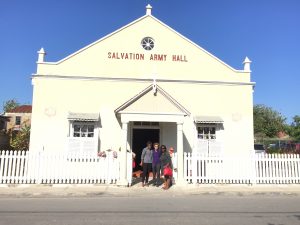
Even before we spoke, Shirley Duncan, a volunteer with Alzheimer’s Jamaica, and one of the event organizers, said, “I have a surprise for you.” She spoke eloquently of the need to talk about dementia, to share experiences, and to be there for the caregivers and people living with dementia. Then she told us that today’s participants were making a commitment to form an on-going group that would educate, advocate, and care for those affected by dementia in their community. “We are calling our group Debron, in honor of you two, because you are the catalysts,” she told us.
Ron had been working with Shirley and Dundeen Ferguson of Alzheimer’s Jamaica for several weeks, setting up the presentation. Shirley and Dahlia Klein orchestrated the details, spreading the word among the community leaders, garnering the venue, and making sure all went smoothly. We were thrilled to be catalysts and delighted to be discussing ideas with such a dedicated group of women, many of whom were former teachers.
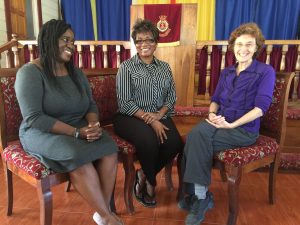 We shared ideas from Dr. Madan Kataria in Mumbai about the power of laughter yoga, and we told a story about creating an inland beach from, Dr. Claire Craig in Sheffield, England. We talked about the power of Dan Cohen’s Music & Memory program and discussed ways to connect through art, citing a story from Teri Miller in Houston, Texas. And we chatted about ways to stay connected through cooking together, sharing our own favorite childhood dishes, which included spiced shrimp, banana porridge, dumplings, roasted corn with shredded coconut, and so much more.
We shared ideas from Dr. Madan Kataria in Mumbai about the power of laughter yoga, and we told a story about creating an inland beach from, Dr. Claire Craig in Sheffield, England. We talked about the power of Dan Cohen’s Music & Memory program and discussed ways to connect through art, citing a story from Teri Miller in Houston, Texas. And we chatted about ways to stay connected through cooking together, sharing our own favorite childhood dishes, which included spiced shrimp, banana porridge, dumplings, roasted corn with shredded coconut, and so much more.
“We will spread these ideas throughout our community,” one of the women told us. “That is what teachers do, we share information.”
We left feeling so inspired and so connected. This is what we all need, caring people, compassionate and eager to learn, ready to offer help and hope.
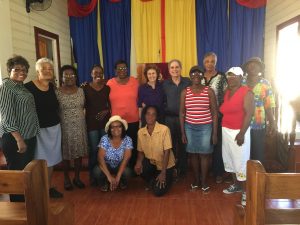
###
During our presentation, we talked about Dr. Madan Kataria’s Ha Ha chorus. At the end, the women said, “We want to sing you a song.” They serenaded us with the Ha Ha chorus. Watch this video and please, sing along.
https://drive.google.com/open?id=0B0elXRV1YrIqUkhqNzN3RkhPSUU
For more about Laughter Yoga, visit Madan Kataria’s website, http://laughteryoga.org
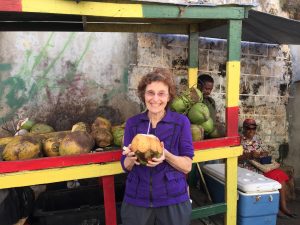
Deborah Shouse is the author of Connecting in the Land of Dementia: Creative Activities to Explore Together and Love in the Land of Dementia: Finding Hope in the Caregiver’s Journey.


Making a Difference, One Island at a Time
 “We are here to explore meaningful ways to stay connected throughout the dementia journey. We are all going to take what we’ve learned and we need the commitment of all of you to help us reach out to the families living with dementia in our communities,” Raymond Jessurun said when he introduced us at a gathering of healthcare professionals, family caregivers, and government representatives. Raymond, who is Secretary of the St. Maarten Alzheimer’s Foundation, is a passionate and inspiring speaker. He urged everyone to join as volunteers of the Alzheimer’s Foundation to spread the meaningful engagement throughout the island, making a difference, one island at a time.
“We are here to explore meaningful ways to stay connected throughout the dementia journey. We are all going to take what we’ve learned and we need the commitment of all of you to help us reach out to the families living with dementia in our communities,” Raymond Jessurun said when he introduced us at a gathering of healthcare professionals, family caregivers, and government representatives. Raymond, who is Secretary of the St. Maarten Alzheimer’s Foundation, is a passionate and inspiring speaker. He urged everyone to join as volunteers of the Alzheimer’s Foundation to spread the meaningful engagement throughout the island, making a difference, one island at a time.
As a group we discussed many engaging activities, including the joy of singing, the nurturing that animals can offer, the power of looking at art, and the creative conversations that cooking together can inspire. We strategized adding more laughter into the day and the importance of knowing each person’s musical preferences. We were also learned of the challenges family caregivers face, which in residential settings as in the Sint Martin’s Home are being addressed by professional caregivers.
 Our host, Bregje Boetekees, Director of the White and Yellow Cross Care Foundation in St. Maarten, was deeply tuned into the importance of offering an array of individualized activities and to the comfort that nature brings to those who are living with dementia. She is overseeing the construction of a new elderly care facility with a large courtyard that will offer safe and ready outdoor access, as well as fertile ground for gardening and other nature-based activities.
Our host, Bregje Boetekees, Director of the White and Yellow Cross Care Foundation in St. Maarten, was deeply tuned into the importance of offering an array of individualized activities and to the comfort that nature brings to those who are living with dementia. She is overseeing the construction of a new elderly care facility with a large courtyard that will offer safe and ready outdoor access, as well as fertile ground for gardening and other nature-based activities.
As always, we left feeling inspired by each of the people we met. Bregje and her team are constantly exploring ways to enrich the lives of their residents who are living with dementia. Raymond and the board members of the Foundation are an example of how a few compassionate and determined people can make a difference. Just eight years ago, Raymond was struggling to find his mother-in-law the dementia care she needed. His advocacy attracted other caregivers and this year their Foundation, which is recognized by Alzheimer’s Disease International, celebrates its seventh year of serving the community. In June, Raymond is co-coordinating a gathering of leaders of Alzheimer’s organizations of 15 Caribbean countries as a step to forming Alzheimer’s Caribbean. These advocates are making a difference, one caregiver at a time, one facility at a time, one island at a time.
###
We invited everyone to join us in Dr. Madan Kataria’s Ha Ha chorus. Watch this and please, sing and laugh along. Click here to view the St. Maarten HaHa Chorus
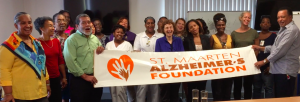
For more about Laughter Yoga, visit Madan Kataria’s website, http://laughteryoga.org
Deborah Shouse is the author of Connecting in the Land of Dementia: Creative Activities to Explore Together and Love in the Land of Dementia: Finding Hope in the Caregiver’s Journey.


